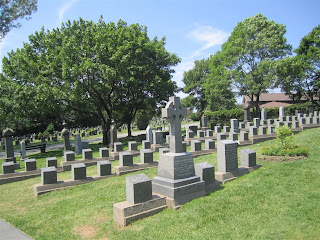
Wednesday, July 27, 2011
Titanic Cemetery
Two days after the Titanic sank in 1912, the White Star Line dispatched the first of four Canadian vessels to search for bodies in the area of the sinking. Of all the recovery vessels, the Mackay-Bennett saw the worst of the tragedy. She was called the "death ship" because her crew recovered 306 bodies from the water. Both the Mackay-Bennett and the Minia were forced to hold burials at sea. In all 209 bodies were brought back to Halifax. The class barriers, so typical of life on board the Titanic, were carefully respected even in death. The bodies of first-class passengers were unloaded in coffins, second-and third-class passengers in canvas bags, and the crew on open stretchers. Only 59 bodies of the bodies placed in the morgue were shipped out by train to their families. The remaining victims of the Titanic were buried in three Halifax cemeteries, the largest was Fairview Lawn Cemetery containing 121, which is the one that we went to. The other two were a Catholic and a Jewish cemetery. The bodies recovered from the icy Atlantic Ocean were numbered for identification purposes. The identification numbers appear on the victims' headstones. The system, established to record observations about the Titanic victims, their clothing, jewelery, and other personal effects, proved invaluable in December 1917 when Halifax was devastated by an explosion that took the lives of nearly 2000 people.


Subscribe to:
Post Comments (Atom)





No comments:
Post a Comment